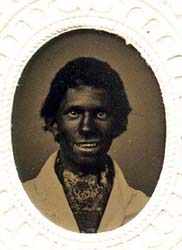
|
One thing to notice about this photograph is that it was made in Glen Falls, New York, around the time of the Civil War.
The extreme racial stereotyping that characterized the minstrel show was very popular in northern regions, and it is important to bear in mind that this form of racism was widespread in the United States. Blackface and the minstrel show was a form of mock reverse passing from white to black. In actual passing, a person attempts to convince others that they embody a different identity than would normally be ascribed to them. But in blackface, white performers played with taking on the persona of blacks for an audience that would still see them as white.
This mock passing played on the fascination with racial boundaries. Comedy works on the borders of hysteria, and blackface touched a nerve by presenting a white person as black, exploiting a deep-seated anxiety about racial identity and purity ― but at the same time, this anxiety would be quelled by the audience knowing the performers was “really” white and by the demeaning representation of blacks, which would reassure them of their distance from the characters depicted. The audience could then return to a reassured sense of possessing their whiteness as a mark of genuine superiority, combined with a feeling of mastery over the black archetypes captured and forced, as the audience saw such performances, to reveal themselves in the caricatured forms of blackface. |

